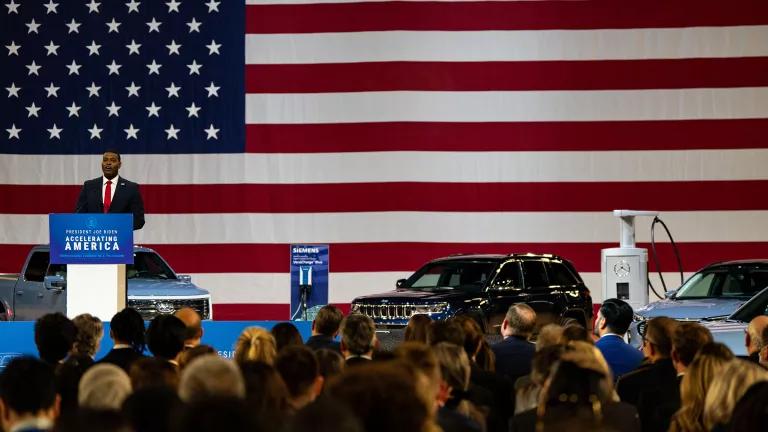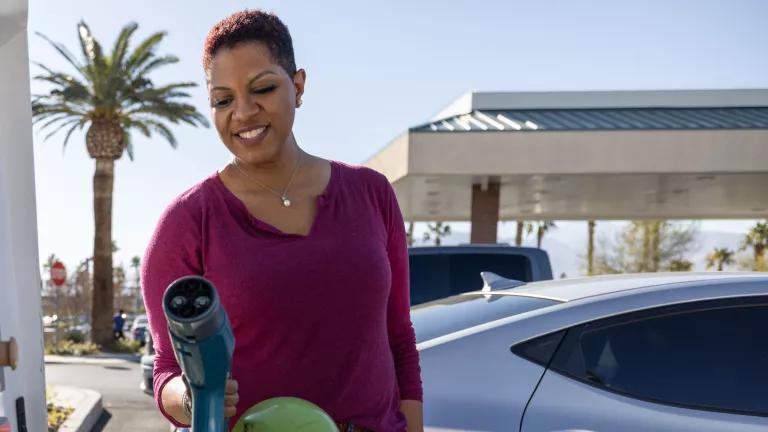Congress Drives Toward a Cleaner Future
The Build Back Better Act makes historic investments in transit and accelerates the transition to electric vehicles. Now it’s the Senate’s turn to pass it.

A construction site for the Honolulu Rail Transit Project in Honolulu
The Build Back Better Act makes historic investments in transit and accelerates the transition to electric vehicles. Now it’s the Senate’s turn to pass it.
Today, the U.S. House of Representatives passed the Build Back Better Act, a momentous shot in the arm for creating a clean transportation system that increases affordable mobility for all. The bill makes historic investments in transit and accelerates the transition to electric cars, buses, and trucks with no tailpipe pollution. The Senate should pass the bill now.
Making Communities Safer and More Affordable
First, the bill includes a new, unique Affordable Housing Access Program to be implemented jointly by the departments of Transportation and Housing and Urban Development. Addressing our affordable housing crisis by bundling preservation or construction of affordable homes with new or expanded bus stops and/or train stations is important since transit service helps us combat climate change by reducing fossil fuel use. For example, transit use saves 6 billion gallons of gasoline annually (see this source for that and many more facts about transit), something we can all appreciate right now given the run-up in prices at the pump.
Bus and train services also reduce racial and economic inequities by delivering better access to jobs, services, and education to communities across America. This matters to low-income and Black and brown communities most since:
- 60 percent of transit riders are people of color.
- One in five riders has a household income below $15,000 a year.
- Nearly half—46 percent—have no car available to them on a regular basis.
Also, many students take transit, particularly in places that don’t have yellow school buses, and kids take public buses to school in cities such as in Baltimore and Washington, D.C..
Many people don’t think about it but owning and operating a car is expensive. In fact, it costs about $9,000 a year, or $700 to $800 per month. That’s a big reason why the lowest-income Americans spend 30 percent of their income on transportation.

Transit riders wait for an all-electric articulated bus as it pulls into a stop in East Harlem, New York City.
Thankfully, transit is a much more affordable option. Making investments in our transit system is one of the smartest things we can do to address racial inequities, create jobs, boost the economy, and address our climate crisis.
After all, it’s time to make some changes. Over the past century, the United States has spent hundreds of billions of dollars building roads and highways. Except in a few remote locations, roads are everywhere. People who drive never have to stop and think, “Is there going to be a road available where I need to go?” But for anyone who relies on transit, that freedom of mobility is missing because transit in the United States has long been underfunded.
The Build Back Better Act also has a new program targeted explicitly at tackling climate change: Community Climate Incentive Grants. This innovative program is sure to be taken up quickly and effectively, funding an array of climate-friendly options, including bike lanes and bus or train service, as well as upgrades to existing rail stations and bus shelters. Another new program complements this local initiative with $10 billion in grants to build or upgrade rail transportation between cities.
The bill includes investments in tearing down, relocating, and redesigning highways that were harmfully rammed through communities in the 20th century. These were serious planning and spending mistakes that divided neighborhoods and subjected those who live in them to multigenerational damage. There are glaring examples in major cities, including Baltimore, New Orleans, and Syracuse.
This program, which can be used not just to remove or resite existing facilities but also to mitigate damage from them (for example, by building noise barriers), will help repair some of those injustices. And it’s a down payment on the work ahead to heal and reconnect neighborhoods in cities nationwide.
Making Pollution-Free, Hassle-Free Road Trips Possible
Americans are jumping at the chance to drive electric vehicles—EV sales hit a record of 170,000 in the second quarter of this year. And it makes sense: In addition to not producing any tailpipe pollution, EVs can save drivers from $6,000 to $10,000 over the life of the vehicles, thanks to lower fuel and maintenance costs and less depreciation. Also, EVs are fun to drive! Without an engine, the cabin is quiet and comfortable, and thanks to the torquing nature of EV motors, many have great acceleration. However, EVs still make up less than 3 percent of all passenger car and light truck sales. Fortunately, the Build Back Better Act is providing a much-needed boost to help put EVs in all driveways.
To accelerate this change, the bill would completely revamp the way the federal government provides incentives on EVs. It would make it so that no matter which automaker buyers go to, they would be eligible for a refundable $7,500 tax credit (which means buyers get the credit no matter their tax liability), with an option to receive the value of the credit at the time of sale. If the car has an American-made battery, the tax credit would get an additional $500; and if the car is made by workers belonging to a union, the credit grows by an additional $4,500. This means some cars could have credits as high as $12,500, rewarding American manufacturing and creating high-quality careers in addition to the environmental benefits.

A worker checks connections on a battery panel for the Lucid Air prototype electric vehicle being manufactured at Lucid Motors headquarters in Newark, California.
To address concerns about wealthy EV buyers taking advantage of this credit, the credit is limited to middle-class households and will not apply to expensive luxury cars.
Recognizing that the average car buyer is often buying a used car, the bill adds a new used-EV tax credit that would let buyers with household incomes less than $75,000 receive up to $4,000, or up to 50 percent of the vehicle price on any used EV costing less than $25,000.
The bill also takes on heavy-duty vehicles like trucks and buses, some of the biggest polluters on the roads. These vehicles typically have diesel power trains and are some of the oldest vehicles on the road, producing dangerous nitrogen oxide pollution that causes respiratory problems for families living near highways, ports, and freight hubs. Moreover, the school buses, garbage trucks, and delivery and mail trucks that travel through neighborhoods all exacerbate the problem.
To address this, the bill includes updated tax credits for commercial purchasers of medium- and heavy-duty EVs; creates a new $5 billion grant program at the U.S. Environmental Protection Agency (EPA) for upgrading heavy-duty EVs; provides $3.5 billion to reduce pollution at ports; and allocates $6 billion to electrify the U.S. Postal Service fleet, with an additional $3 billion to electrify the rest of the federal vehicle fleet.

A Chevy Bolt, part of the city of St. Louis’s new EV fleet, is plugged into a charging station
Finally, to make sure all of these new EVs will have places to charge, the bill expands, extends, and makes refundable the tax credit for installing an EV charger; creates a new $1 billion grant program to install chargers in low-income, rural, and underserved communities; and dedicates $2 billion of a new Greenhouse Gas Reduction Fund to grants for municipalities to install EV chargers. This is on top of the $7 billion in the Infrastructure Investment and Jobs Act to build out a national network of EV chargers on U.S. highways.
The Build Back Better Act makes EVs more affordable and easier to own. Upcoming family trips from Maine to Miami or Long Island to Los Angeles will be smooth with hundreds of thousands of public charging stations deployed along highways, thanks to the large investment in grants and tax credits.
Importantly, the Build Back Better Act investments complement vehicle emission standards that will ensure consumers and businesses have a growing number of electric vehicles from which to choose. The administration recently proposed tighter emissions standards for new cars made through model year 2026. The EPA should also set clean car standards for future years that will reduce carbon pollution by 60 percent below today’s cars by 2030—a target that can be achieved with at least 50 percent EV sales—and put us on the path to 100 percent pollution-free car sales by 2035. The administration should also move quickly to set strong standards on medium- and heavy-duty trucks to ensure the complete shift to pollution-free transit buses and freight trucks.

An all-electric Proterra bus travels through Stockton, California
Building Better Jobs
One other benefit people may experience is in getting a job providing transit services or manufacturing electric vehicles. The bill aims to make it a reality that a cleaner economy will also be an economy where workers have good jobs. The bill includes key workforce development programs to ensure frontline transit workers are trained to safely repair, maintain, and operate vehicles with this new technology. Additionally, the bill’s bonus credit for EVs produced by union labor will, for the first time, reward companies and workers for organizing to protect their rights and jobs. Transit and manufacturing jobs have long been a pathway to the middle class for millions and investing in these areas will create even more of them.
The House is putting us on the right track when it comes to crafting a cleaner, more equitable transportation system, and the Senate should follow quickly by passing the final bill and sending it to the president’s desk. With support from strong standards and innovations by the private sector, these crucial investments will provide more options for safe bike and pedestrian trips and easier, more frequent transit access. And they will slash tailpipe pollution, helping us address the climate crisis. These investments are historic. Now it’s time to put it into drive and get going!



